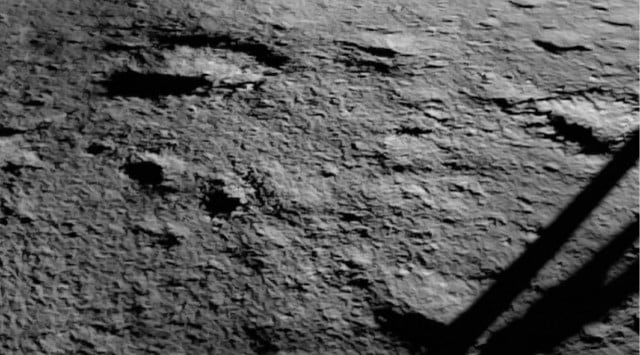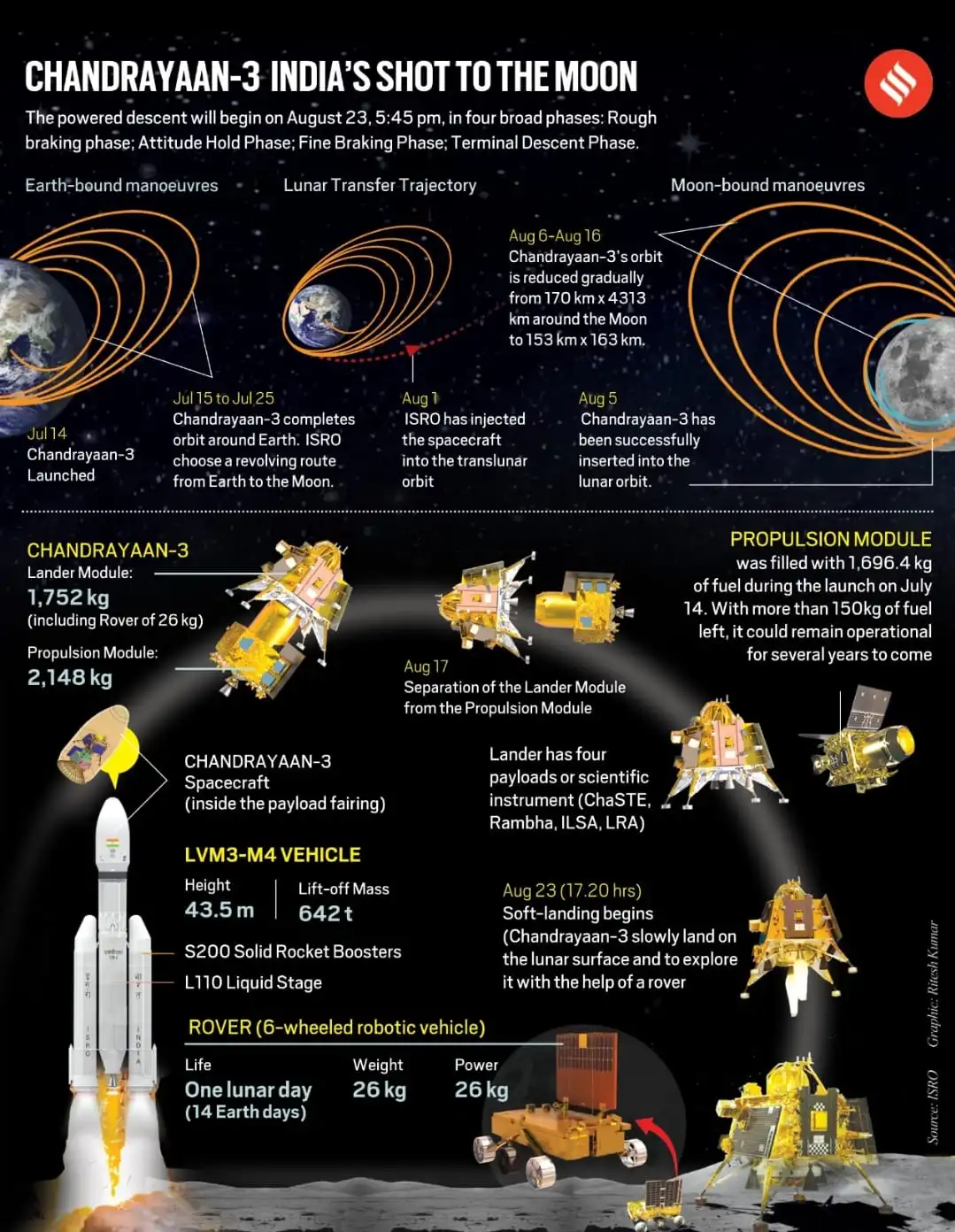Chandrayaan-3 first to land near Moon’s south pole; all eyes on rover, ISRO says ‘craft healthy’
In a feat hailed by space agencies and leaders from across the world, India became only the fourth country to successfully land a spacecraft on the Moon -- after the erstwhile Soviet Union, United States and China — just three days after a failed attempt by Russia’s Luna-25 mission.
 An ISRO image of the Chandrayaan-3 landing site taken after touchdown. One of the four legs of the lander is visible on the right
An ISRO image of the Chandrayaan-3 landing site taken after touchdown. One of the four legs of the lander is visible on the right Rarely do the literal and the figurative blend together so effectively. They did Wednesday evening as the Chandrayaan-3 landed gently on the lunar surface: India was over the moon.
Scripting history and defining the finest moment till date of the Indian space programme, the Chandrayaan-3 Lander Module touched down on the Moon, near its south pole, at 6.04 pm after 17 minutes of powered descent, becoming the first spacecraft to land in the unexplored lunar region, believed to be a reservoir of frozen water key to future space missions.
“We have achieved a soft-landing on the Moon. India is on the Moon,” Indian Space Research Organisation (ISRO) Chairman S Somanath announced, triggering applause and celebrations not just among scientists who had gathered in hundreds at the ISRO Telemetry, Tracking and Command Centre in Bengaluru, but across the nation with millions glued to TV sets for the final descent.
In a feat hailed by space agencies and leaders from across the world, India became only the fourth country to successfully land a spacecraft on the Moon — after the erstwhile Soviet Union, United States and China — just three days after a failed attempt by Russia’s Luna-25 mission.
Prime Minister Narendra Modi, who had joined via a video link from Johannesburg where he is attending the BRICS Summit, said, “This achievement of the Chandrayaan lunar missions will take India much further than the Moon. We will test the limits of our solar system and will work towards realising the possibilities of space exploration for the benefit of humankind.”
His remarks and the success of the mission underlined India’s rise as a space and technology powerhouse amid her assertion for a seat at the global high table.
In a tweet, ISRO relayed a message from Chandrayaan-3: “India, I reached my destination and you too!”.
Some four hours later, after letting the dust from the landing settle down, a 26-kg rover emerged from the Lander Module, and began sliding on a ramp to reach the Moon’s surface.
The six-wheeled rover, which is carrying two instruments and moves very slowly, is expected to crawl on the surface for the next 14 days, conducting chemical and elemental analysis of lunar soil and rocks.

The Lander Module, which will remain stationary, carries four instruments that will record chemical, thermal and seismic measurements of the Moon’s surface.
The lander and the rover are equipped with cameras and can photograph each other. During their stay on the Moon, ISRO is likely to receive hundreds of photographs of the lunar surface, and of the instruments doing their work.
Wednesday’s landing came four years after the disappointment of Chandrayaan-2 which crashed on the lunar surface while making a similar attempt at soft-landing.
The Moon landing establishes ISRO as a serious and leading player in planetary exploration. ISRO has already sent an Orbiter to Mars in 2014, and has plans to study the Sun and Venus, and also send humans to space. The Aditya-L1 mission, ISRO’s first to study the Sun, is slated for launch this September.
At the mission control room, Somanath said, “We had a very soft landing and it actually achieved most of the nominal conditions for landing including the velocity of touchdown. The velocity was far less than the 2 m/sec that was considered as the nominal velocity and this gives us a lot of confidence that the health of the craft will be very good and we will be able to continue with experiments including the Pragyaan rover coming out and doing experiments.”
“We are very excited to see this mission succeed. It was not an easy task at all. It was the work of so many years. (The failed) Chandrayaan-2 was the work of many years and Chandrayaan-3 for the last four years. The learning from Chandrayaan-2 really helped us in perfecting the methodology and we also had a large number of experiments and tests. And that has paid dividends today,” he said.
M Shankaran, Director of the UR Rao Space Centre which built the Chandrayaan-3 orbiter and lander, and one of the key persons in the mission operation, said he continued to have fears about the mission till the last minute.
“I was not very confident because we have seen issues a couple of times. As a person working in this domain for 36 years, I know there are a thousand things that can go wrong. The success is a reflection of the effort that has been put in,” he said.







